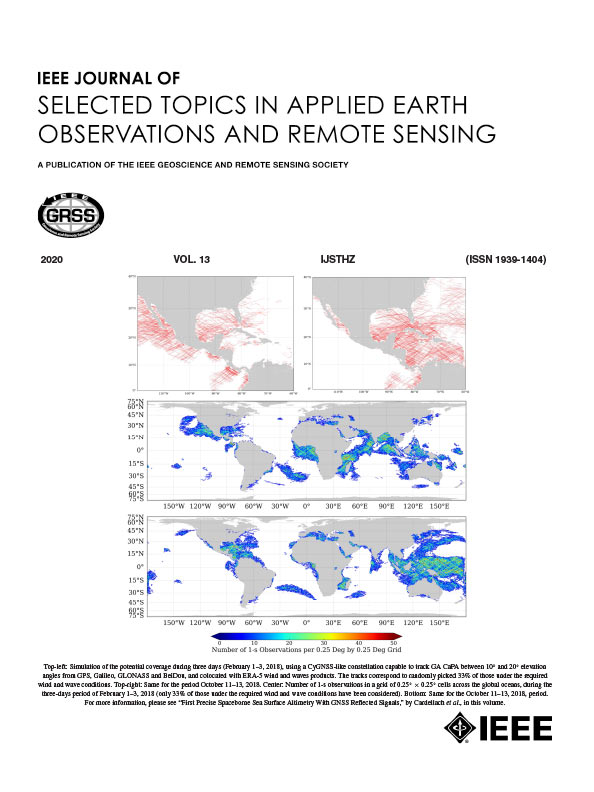Aerosol Optical Depth Retrieval Over Ocean and Land From Fengyun-3F MERSI-III: First Results and Validation
IF 5.3
2区 地球科学
Q1 ENGINEERING, ELECTRICAL & ELECTRONIC
IEEE Journal of Selected Topics in Applied Earth Observations and Remote Sensing
Pub Date : 2025-09-24
DOI:10.1109/JSTARS.2025.3613696
引用次数: 0
Abstract
The Fengyun-3F (FY-3F) satellite, China’s latest launched polar-orbiting meteorological satellite with morning overpass, carries the advanced Medium Resolution Spectral Imager-III (MERSI-III). Sharing similar characteristics with the Moderate Resolution Imaging Spectroradiometer (MODIS), MERSI-III/FY-3F has the potential to fill the observational gap in morning-orbit aerosol monitoring once Terra’s mission concludes. This study adapts the aerosol retrieval algorithm originally developed for the MERSI-II sensor aboard the FY-3D satellite to the MERSI-III sensor. Algorithm improvements have been made to accommodate MERSI-III’s characteristics, primarily focusing on optimizing the surface reflectance estimation model and updating the lookup tables. The improved algorithm has been applied to global MERSI-III observations for the entire year of 2024, and the first aerosol optical depth (AOD) retrieval results over ocean and land for this sensor have been produced and validated. The results show that MERSI-III AOD retrievals agree well with Aerosol Robotic Network data, with 69.8% and 71.0% of retrievals falling within expected error (EE) envelopes over ocean [± (0.03 + 10% )] and land [± (0.05 + 20% )], respectively. The accuracy of MERSI-III retrievals is comparable to that of Terra MODIS dark target products (EE: 65.3% over ocean, 73.4% over land). Comparative analysis of collocated MERSI-III and MODIS AOD datasets reveals consistent spatial patterns, although regional biases are observed in areas with high aerosol loading and near desert fringes. These results indicate that MERSI-III/FY-3F can provide reliable global aerosol observations and is expected to serve as an important candidate for the AOD data record from the morning-orbiting Terra/MODIS satellite.风云- 3f MERSI-III海洋和陆地气溶胶光学深度反演:初步结果与验证
风云- 3f (FY-3F)卫星是中国最新发射的具有早晨立交桥的极轨气象卫星,携带先进的中分辨率光谱成像仪- iii (MERSI-III)。MERSI-III/FY-3F与中分辨率成像光谱仪(MODIS)有着相似的特点,一旦Terra任务结束,它有可能填补早晨轨道气溶胶监测的观测空白。本研究将原本为FY-3D卫星上MERSI-II传感器开发的气溶胶检索算法应用于MERSI-III传感器。为了适应MERSI-III的特点,对算法进行了改进,主要集中在优化表面反射率估计模型和更新查找表上。将改进后的算法应用于MERSI-III卫星2024年全年的全球观测,获得了该传感器首次海洋和陆地气溶胶光学深度(AOD)反演结果并进行了验证。结果表明,MERSI-III AOD反演结果与气溶胶机器人网络(Aerosol Robotic Network)数据吻合较好,分别有69.8%和71.0%的反演结果落在海洋[±(0.03 + 10%)]和陆地[±(0.05 + 20%)]的预期误差(EE)包络内。MERSI-III反演精度与Terra MODIS暗目标产品相当(海洋EE: 65.3%,陆地EE: 73.4%)。同时配置的MERSI-III和MODIS AOD数据集的对比分析显示了一致的空间格局,尽管在气溶胶负荷高的地区和靠近沙漠边缘的地区存在区域偏差。这些结果表明,MERSI-III/FY-3F能够提供可靠的全球气溶胶观测数据,有望作为Terra/MODIS晨轨卫星AOD数据记录的重要候选数据。
本文章由计算机程序翻译,如有差异,请以英文原文为准。
求助全文
约1分钟内获得全文
求助全文
来源期刊
CiteScore
9.30
自引率
10.90%
发文量
563
审稿时长
4.7 months
期刊介绍:
The IEEE Journal of Selected Topics in Applied Earth Observations and Remote Sensing addresses the growing field of applications in Earth observations and remote sensing, and also provides a venue for the rapidly expanding special issues that are being sponsored by the IEEE Geosciences and Remote Sensing Society. The journal draws upon the experience of the highly successful “IEEE Transactions on Geoscience and Remote Sensing” and provide a complementary medium for the wide range of topics in applied earth observations. The ‘Applications’ areas encompasses the societal benefit areas of the Global Earth Observations Systems of Systems (GEOSS) program. Through deliberations over two years, ministers from 50 countries agreed to identify nine areas where Earth observation could positively impact the quality of life and health of their respective countries. Some of these are areas not traditionally addressed in the IEEE context. These include biodiversity, health and climate. Yet it is the skill sets of IEEE members, in areas such as observations, communications, computers, signal processing, standards and ocean engineering, that form the technical underpinnings of GEOSS. Thus, the Journal attracts a broad range of interests that serves both present members in new ways and expands the IEEE visibility into new areas.

 求助内容:
求助内容: 应助结果提醒方式:
应助结果提醒方式:


